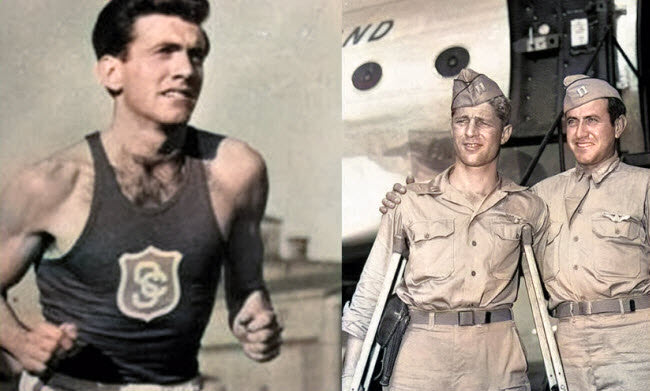American runner Louis Zamperini is celebrated as one of the most distinguished American athletes, having honored his country on two significant occasions. First, as an athlete in the 1936 Berlin Olympics, where he set impressive records that garnered praise from then-German leader Adolf Hitler. Later, Zamperini served as a war hero in the U.S. Air Force during World War II, where he faced near-death experiences after his bomber crashed in the Pacific Ocean. He survived 47 days at sea before being captured as a prisoner of war in a Japanese internment camp, where he remained for two years. Initially presumed dead by the U.S. government, he was later confirmed alive after Japan’s surrender. Throughout his life, Zamperini received two major honors: one as an Olympic runner and another as a hero of the United States during the war.

Early Life and Athletic Career:
Born on January 26, 1917, in Olean, New York, Louis Zamperini grew up in a first-generation Italian Catholic family. His family later moved to Torrance, California. From a young age, Zamperini’s life was marked by adversity, including near-drowning as a child and nearly dying in a house fire. He also faced constant bullying due to his immigrant parents’ lack of English proficiency. At fifteen, he joined the track and field team, where he not only succeeded but set records that went unbroken for 20 years. Zamperini set the national high school record in 1934, earning a scholarship to the University of Southern California. He later ran 5000 meters in one of the worst heatwaves the country had ever seen, gaining national fame. It was only natural that he would represent his country in the 1936 Berlin Olympics. During the event, he found himself just a few meters from Nazi leader Adolf Hitler, whom he found amusing, almost like a character from a Laurel and Hardy film. Despite finishing eighth in the 5000 meters, Zamperini’s last lap in 56 seconds was so remarkable that Hitler requested to speak with him, referring to him as “the boy with the fast finish.”

World War II and Survival:
After the Olympics, Zamperini hoped to compete in the 1940 Games, but World War II interrupted his plans. He was drafted and joined the U.S. Army Air Corps in Europe. Following the attack on Pearl Harbor, Zamperini actively participated in combat. In April 1943, he piloted a B-24 bomber on a mission over Japan in the Pacific Theater. A month later, while on a search mission for a missing plane, his bomber experienced a malfunction and crashed into the ocean with eleven men aboard. Only Zamperini and two others—co-pilot Russell Phillips and tail gunner Francis McNamara—survived. The trio spent weeks adrift, facing hunger, heat, thirst, and shark attacks, surviving solely on rainwater and catching strange fish. During their ordeal, Zamperini’s parents received a condolence letter from President Franklin Roosevelt in June 1943, even though their son was still alive, as the U.S. government had mistakenly believed he was dead.

Internment and Liberation:
During their time adrift, McNamara died on the 33rd day at sea, and Zamperini lost over 20 kilograms before they finally reached the Marshall Islands. They were captured by the Japanese and moved from one internment camp to another until they settled in a camp led by war criminal Sergeant Mutsuhirio Watanabe. There, Zamperini and his fellow prisoners endured daily beatings until 1945. Zamperini recalls these moments, saying, “I could endure physical punishment, but it was the attempt to destroy your dignity and make you feel insignificant that was the hardest to bear.” His suffering intensified when camp officials learned of his Olympic background, subjecting him to increased hunger and abuse and intentionally separating him from Phillips to heighten his psychological distress. Fortunately, with Japan’s surrender, the camp was liberated in the fall of 1945, and Zamperini returned to the United States, having come back from the brink of death.

Post-War Life and Legacy:
Upon returning home, Zamperini faced challenges adjusting to life after the harrowing experiences in the internment camp, which had a negative impact on his life. He nearly divorced his wife, Cynthia, but gradually overcame these issues. In his later years, he devoted himself to giving motivational speeches, helping others overcome their struggles. He even confronted his past during a torch relay for the 1998 Winter Olympics in Japan, running near the Naoetsu Mountains. Louis Zamperini passed away in 2014 at the age of 97, leaving behind a legacy as both a legendary Olympic athlete and a war hero.
